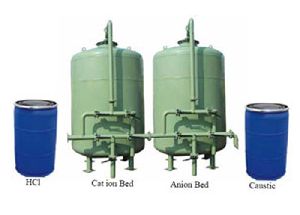
Pouch Packing Machine
225,000 Per Piece
1 Piece (MOQ)

Filling Machine
Get Price Quote
We are capable of meeting bulk or urgent requirements effortlessly due to our latest inventory management system and automated management. By this, the stocks are piled up safely to ensure delivery without loss. We efficiently cater to the varied demands of the clients and offer them personalized packaging options as well. We ensure that the products are packed sternly using quality packaging material to evade loss. Features: High-Performance Sturdy Structure Long Service Life
Best Deals from Filling Line

Demineralised Water Plant
Get Price Quote
DeionizersAQUA LIFE GUARD RO System is a leading provider of deionization solutions. Our water deionizers are rugged, pre-engineered, pre-assembled, standardized units that minimize expensive installation and start-up costs. We have designed our Deionization systems to maximize the efficiency and repeatability of the unit during the service and regeneration modes The Process of Deionization or Ion-exchangeIn the context of water purification, ion-exchange is a rapid and reversible process in which impurity ions present in the water are replaced by ions released by an ion-exchange resin. The impurity ions are taken up by the resin, which must be periodically regenerated to restore it to the original ionic form. (An ion is an atom or group of atoms with an electric charge. Positively-charged ions are called cations and are usually metals; negatively-charged ions are called anions and are usually non-metals). The following ions are widely found in raw waters:Ion Exchange ResinsThere are two basic types of resin - cation-exchange and anion-exchange resins. Cation exchange resins will release Hydrogen (H+) ions or other positively charged ions in exchange for impurity cations present in the water. Anion exchange resins will release hydroxyl (OH-) ions or other negatively charged ions in exchange for impurity anions present in the water. The application of ion-exchange to water treatment and purification. There are three ways in which ion-exchange technology can be used in water treatment and purification: first, cation-exchange resins alone can be employed to soften water by base exchange; secondly, anion-exchange resins alone can be used for organic scavenging or nitrate removal; and thirdly, combinations of cation-exchange and anion-exchange resins can be used to remove virtually all the ionic impurities present in the feedwater, a process known as deionization. Water deionizers purification process results in water of exceptionally high quality. DeionizationFor many laboratory and industrial applications, high-purity water which is essentially free from ionic contaminants is required. Water of this quality can be produced by deionization.The two most common types of deionization are : Two-bed deionization Mixed-bed deionization Two-bed deionizationThe two-bed deionizer consists of two vessels - one containing a cation-exchange resin in the hydrogen (H+) form and the other containing an anion resin in the hydroxyl (OH-) form. Water flows through the cation column, whereupon all the cations are exchanged for hydrogen ions. To keep the water electrically balanced, for every monovalent cation, e.g. Na+, one hydrogen ion is exchanged and for every divalent cation, e.g. Ca2+, or Mg2+, two hydrogen ions are exchanged. The same principle applies when considering anion-exchange. The decationised water then flows through the anion column. This time, all the negatively charged ions are exchanged for hydroxide ions which then combine with the hydrogen ions to form water (H2O). Mixed-bed deionization In mixed-bed deionizers the cation-exchange and anion-exchange resins are intimately mixed and contained in a single pressure vessel. The thorough mixture of cation-exchangers and anion-exchangers in a single column makes a mixed-bed deionizer equivalent to a lengthy series of two-bed plants. As a result, the water quality obtained from a mixed-bed deionizer is appreciably higher than that produced by a two-bed plant. Although more efficient in purifying the incoming feedwater, mixed-bed plants are more sensitive to impurities in the water supply and involve a more complicated regeneration process. Mixed-bed deionizers are normally used to ‘polish' the water to higher levels of purity after it has been initially treated by either a two-bed deionizer or a reverse osmosis unit. Electrodeionization EDI Systems remove ions from aqueous streams, typically in conjunction with reverse osmosis (RO) and other purification devices. Our high-quality deionization modules continually produce ultrapure water up to 18.2MW/cm. EDI may be run continuously or intermittently

Sealing Machine
Get Price Quote
duplex plodder, gyratory sieve, Detergent Powder Mixer, Screw Conveyor

Atta
Get Price Quote

Pouch Packing Machine
Get Price Quote
AGARBATTI POUCH PACKING MACHINE, Oil Pouch Packing Machine

Industrial Water Treatment Plant
Get Price Quote
Industrial Water Treatment Plant, Commercial Water Treatment Plant

Packaging Machine
Get Price Quote
Packaging Machine, Spiral Mixer Big Machine, Shrink Wrapping Machine

Water Treatment Plant
Get Price Quote
solar thermal water heater, water treatment component

Cold Drink Vending Machine
Get Price Quote
Cold Drink Vending Machine, ice cream plant, bakery display counter

Water Treatment Plants
Get Price Quote
Water Treatment Plants, pumps & pumping equipment, Butterfly Valves, Sarees

Sand Blasting Machine
Get Price Quote
Sand Blasting Machine

Adhesives
Get Price Quote
Pu Sheet, phenolic, Packaging, Maleic Resins, Ester Gum, Epoxy, emulsions

Industrial Water Treatment Plant
Get Price Quote
Cement, Clinker, Emu Oil, natural skin care products

Packaging Machine
Get Price Quote
Packaging Machine, detergent powder packaging machine, Pouch Packaging Machine

Adhesives
Get Price Quote
Foam, Fabric